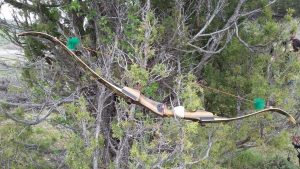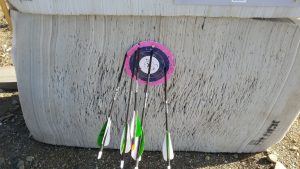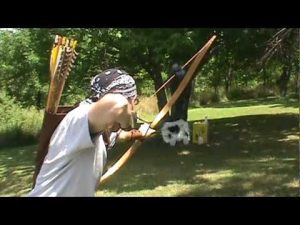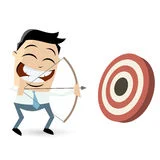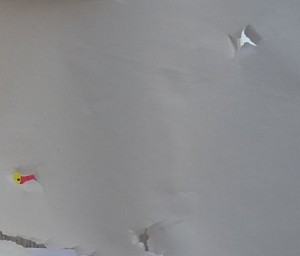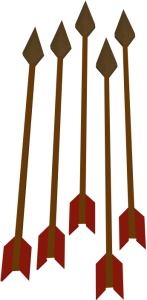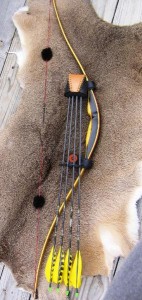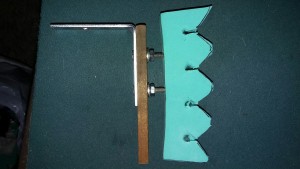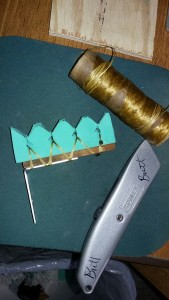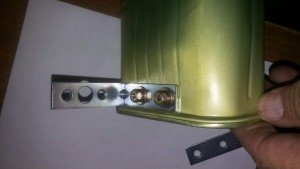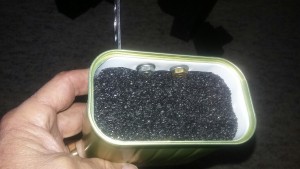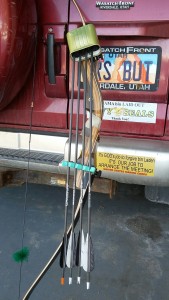 Weasel and I went shooting a 3D course up at Hardware Ranch yesterday. This range was set up and run by the Cache Archers out of the Logan Utah area. There were two courses with 20 targets on each of the courses. Targets ranged from about 15 yards out to 101 yards. Most were in the 20 to 40 yard distances. All classes of archers like to come to events like this one to show off their talents, make a few side bets and just have a good time.
Weasel and I went shooting a 3D course up at Hardware Ranch yesterday. This range was set up and run by the Cache Archers out of the Logan Utah area. There were two courses with 20 targets on each of the courses. Targets ranged from about 15 yards out to 101 yards. Most were in the 20 to 40 yard distances. All classes of archers like to come to events like this one to show off their talents, make a few side bets and just have a good time.
Weasel and I paid our entry fees and then went for a good time. We left the score sheets at home. We counted hits and misses and it didn’t matter if the hit was in the foot of the target or in the bulls eye…a hit is a hit is a hit! And before the shooting was all done it seemed like I favored bears feet and legs more so than the body of the target. I did hit one in the butt however.
With my less than skilled level of shooting and only 4 sacrificial arrows in my arsenal, I had to be choosey about which targets I was going to shoot at. A high level of confidence was necessary for me to take the shot, as arrant arrows tend to shatter upon impact in the rocks. Shooting a traditional bow, with no sights, I am totally relying on my own ability to trust in my “arrow throwing” ability to reach the target and not go over or under it. I did go over and under several targets during the day, but luckily for me, I only found one rock and lost one arrow.
Weasel, on the other hand, has his confidence level so high, he shot his arrows at each of the targets sitting deeply in the rocky outcrops and without fail both of his arrows found their mark. I, on the other hand, chose to set out on those two shots.
The course lends itself well to “real shooting” situations if one is inclined to hunt big game with their arrow flipper. Of course if a big old mule deer buck was laying where this one is on the left, you would not hesitate to shoot a broad head yielding arrow at it if you were within your shooting and hitting range. I would have to be about 1/3rd closer in real life to take this shot, but a miss would mean a busted or lost arrow, a hit would mean liver and onions would be served soon!
Changing the subject: You have read my comments about FOC…right? FOC is the acronym for “Front Of Center” and it refers to weight on the point end of the arrow. A heavy front end yields itself to better penetration when you hit the target. Some folks like to have a very high percentage of weight up front and FOC is usually given as a percentage number comparing the balance point forward of the center of the arrow shaft without any tips, feathers or anything else attached to the shaft. It is obvious with nothing attached to that shaft on either end, the arrow should balance at the center point of the shaft. If not, then something has to be done to the shaft to make it balance at that point. And then when you add a nock, some feathers etc. to the back or “nock” end of the arrow, the balance point would move back toward that end of the arrow because of the added weight. Placing an insert and point on the other end, makes the balance point move back toward or even beyond the center point and more toward the tip of the arrow for that balance point. More weight on the point end means the balance point moves that much farther away from the center of the arrow shaft toward the tip. OK, enough of that. What is my point in this?
Well, during the course of the day, I shot at one target and when I pulled the arrow out of my perfectly placed shot (somewhere near the foot of the animal target) the whole insert and point came out of the arrow shaft…poor glue is the culprit. So, now I’m down to two sacrificial arrows and a whole lot more targets to go. I put that arrow in my quiver where I would know not to draw it out to shoot it, and saved the insert and point to later glue it back into the shaft.
Well, off we went to enjoy more shooting…me and my two arrows, uninhibited by the fact that each target required two arrows, I would just choose to shoot one arrow at each target when there were two targets at the station. I have no problem doing that.
Near the end of the shoot, we came upon an elk target laying down near a small trickle of water. A beautiful scene and about a 65 yard shot (I can’t remember exactly, but it was a pretty long shot for me) down hill. I confidently shot my first arrow and it came to rest poking up about 10 feet in front of the target. I drew out arrow number two and gave it a fling! This time, it barely went over the top of the target and promptly stuck up in the muddy bank on the other side of the target. A near hit.
When I pulled arrow number two out of the mud, I saw that it was missing its point and insert! I was not a happy guy! Two arrows with the inserts and points pulling out during the day! That does not bode well for the glue used to secure them into the arrow shafts! I voiced my concerns to Weasel who was happily pulling his two perfectly placed arrows from the target and he said, “Did you just shoot the one without the insert”!?! Of course not, I put that arrow aside in my quiver and as I looked down I could plainly see the arrow that had been set aside was gone from its spot! I did shoot the arrow that did not have a tip! And of course, upon further investigation I found the arrow shaft was stuffed full of nice fresh mud! Oh dear!
This morning I pulled that arrow from the quiver and cleaned out the mud. An investigation of the carbon shaft and it appears to be in good shape, no cracks that I can see. Once it is dried I can re-glue the insert in it and it will be good to go as a sacrificial arrow once again!
Now let’s talk about this arrow for a minute. FOC seems to be something an arrow needs in order to fly properly. At least an arrow with a tip on it is usually a good idea to shoot. But this one did not have a tip on it. I measured it and balanced it and took all the careful calculations on this arrow, with no tip on it and the FOC came out NON-FOCed…I’d have to say it had ROC (rear of center) balance. In fact it calculated at 2.68% ROC (-2.68 FOC). HMMMMMM!
At the time I shot this arrow, both Weasel and I were watching the flight as it headed down range toward that laying down elk. It flew beautifully straight and nearly on its mark. How can an arrow with ROC and not FOC fly so well? Theories or facts please people! Had that arrow hit that elk, I would have been elated until I got down to it and found it shattered because that carbon shaft was not protected against the impact of the solid core rubber those targets are made out of. Luckily for me and my arrow, it hit the soft mud and not a rock either. The arrow was saved from sure demise. And had it hit the target I would have been bouncing up and down saying “That arrow Rocked”! And I would have been pretty close to the truth without even knowing it did in fact have ROC.
In conclusion: Thank you for all the very hard work Cache Archers did for putting on this event. It was fun! The day was overcast and cool, which made it even better. The situations of every target made it seem much like a hunting adventure and of course the hiking up and down the hills made for some tough going and a good reminder to us all to get into shape for the upcoming hunting season. We have 3 1/2 months to do that! AND, finally, never shoot a ROC arrow at a game animal, it will not have enough kinetic energy to adequately penetrate for an ethical kill. FOC is the rock! More FOC is better, to a point I’m sure! More ROC is not better…and any ROC is not good.
April 25, 2016
Bears Butt

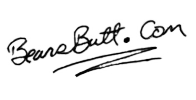
 Utah Fishing Reports
Utah Fishing Reports


